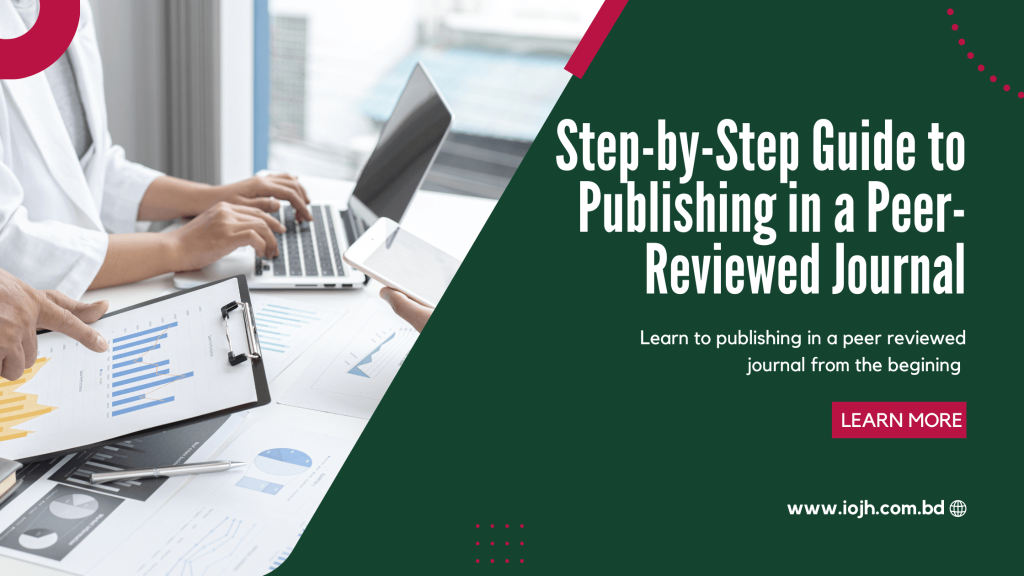Publishing in a peer-reviewed journal is a crucial milestone for researchers, students, and academics. It enhances the credibility of research, helps in career advancement, and contributes to the global knowledge pool. However, the process can be daunting for beginners. This comprehensive guide breaks down the entire process step-by-step, from selecting the right journal to handling peer review and final publication.
What Is Peer Review?
Peer review is the evaluation of a research manuscript by experts in the field before publication. It ensures that the study meets academic standards, is methodologically sound, and contributes to existing knowledge.
Types of Peer Review
- Single-blind review: Reviewers know the author’s identity, but authors do not know the reviewers.
- Double-blind review: Both authors and reviewers remain anonymous.
- Open review: Authors and reviewers are aware of each other’s identities.
Why Is Peer Review Important?
- Ensures research quality and integrity.
- Provides constructive feedback for improvement.
- Enhances credibility and reputation.
Step 1: Choosing the Right Journal
Factors to Consider When Selecting a Journal
- Scope and Aim: Ensure the journal aligns with your research area.
- Impact Factor and Reputation: Higher impact factors indicate greater influence.
- Open Access vs. Subscription-Based: Decide based on accessibility and funding.
- Acceptance Rate: Consider the probability of acceptance.
- Publication Speed: Some journals take longer to process manuscripts.
How to Identify Suitable Journals
- Use journal finder tools (e.g., Elsevier Journal Finder, Springer Journal Suggester).
- Review the journal’s author guidelines.
- Check previous publications to understand their quality.
Step 2: Preparing Your Manuscript
Essential Sections of a Research Paper
- Title: Concise and informative.
- Abstract: A summary of the study (150-250 words).
- Keywords: 3-6 words that reflect the main themes.
- Introduction: Background, research gap, and objectives.
- Methodology: Detailed research design, data collection, and analysis.
- Results: Key findings with supporting data.
- Discussion: Interpretation of results and comparison with existing research.
- Conclusion: Summary, implications, and future directions.
- References: Properly formatted citations.
Formatting and Citation Styles
- Follow the journal’s formatting guidelines (APA, MLA, Chicago, etc.).
- Use reference management tools (Zotero, EndNote, Mendeley).
Step 3: Writing a Strong Cover Letter
A cover letter introduces your manuscript to the editor. It should include:
- A brief summary of your research.
- Why the study is suitable for the journal.
- A statement confirming the manuscript is original and not under review elsewhere.
Example Cover Letter: “Dear [Editor’s Name], I am pleased to submit our manuscript titled ‘[Title of Your Paper]’ for consideration in [Journal Name]. Our research explores [brief summary], which aligns with the journal’s scope. We believe our findings contribute to [specific contribution]. Thank you for considering our submission.”
Step 4: Submitting Your Manuscript
Submission Process
- Register on the journal’s online submission portal.
- Upload the manuscript, cover letter, and supporting documents (data files, ethical approvals, etc.).
- Complete the author declarations and conflict-of-interest statements.
Common Submission Mistakes
- Not following formatting guidelines.
- Missing required documents.
- Submitting to multiple journals simultaneously (not allowed).
Step 5: The Peer Review Process
What Happens After Submission?
- Editorial Screening: The editor checks for plagiarism, scope, and formatting.
- Peer Review: Experts evaluate the manuscript.
- Decision Making: The editor makes a decision based on reviewer feedback.
- Author Revisions: If necessary, authors revise and resubmit.
Possible Review Outcomes
- Accept without changes: Rare but ideal.
- Minor revisions: Small corrections required.
- Major revisions: Significant changes needed.
- Reject with resubmission option: Encourages substantial improvements.
- Reject outright: Manuscript does not meet journal standards.
Step 6: Responding to Reviewer Comments
How to Handle Reviewer Feedback
- Be Professional and Respectful: Even if you disagree.
- Address All Comments: Provide clear explanations for changes.
- Use a Response Letter: Outline your revisions and justifications.
Example Response: “Reviewer 1 suggested clarifying the methodology. We have revised Section 3.2 to provide additional details on data collection.”
Step 7: Final Acceptance and Proofreading
Final Checks Before Acceptance
- Ensure all requested changes are made.
- Double-check references and formatting.
- Verify authorship and acknowledgments.
Proofreading and Final Edits
- Use tools like Grammarly or professional proofreading services.
- Read the final version aloud to catch errors.
Step 9: Publication and Promotion
Types of Publication
- Early Online Release: Available before appearing in print.
- Full Journal Issue: Published in a specific volume and issue.
How to Promote Your Research
- Share on Social Media (LinkedIn, ResearchGate, Twitter).
- Present at Conferences.
- Write Blog Summaries.
- Engage with the Research Community.
Conclusion
Publishing in a peer-reviewed journal requires careful planning, persistence, and attention to detail. By following this step-by-step guide, researchers can navigate the process successfully and contribute valuable knowledge to their field.
